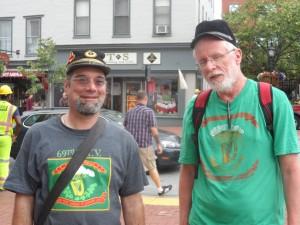July 1, 2013
After following the footsteps of the Last March of The Iron Brigade, my covivant and I found ourselves on the opposite side of town from our horseless carriage. We sat on the lawn of the Lutheran Seminary listening to a band in blue uniforms perform period music. We were munching on the rations that we had brought along. Mine was a ham sandwich. Although I really like CV’s vegetarian cooking and have developed a real taste for seitan, I doubt I will ever fully convert, especially when it comes to sandwiches. We had noticed traffic conditions approaching gridlock during our “march”, so rather than take the shuttle, we decided to walk across town to the Gettysburg National Cemetery. Oddly, this was arguably another “real time” experience as we were again in the footsteps of federal soldiers exactly 150 years before, who were in a much more desperate race to get to the high ground south of the town.
Those “Rowdy” Reenactors
We stopped for coffee at a place called The Ragged Edge. I picked up a copy of the Gettysburg Times, the front page stories were mainly about the New Birth of Freedom event, featuring Doris Kearns Goodwin, that CV and I had attended Sunday night. A brief story on page 3 caught my eye – “Arrest at re-enanctment”. It told the story of state police being called to the re-enactment site of the Blue Gray Alliance, Friday night, to deal with a disturbance. A fellow from Georgia was intoxicated and going from tent to tent trying to start a fight.
You have to remember there were over ten thousand reenactors participating in the weekend’s events. These are fellows who have weapons – obsolete, but quite deadly. They are reenacting events about which emotions in some quarters still run rather high. The only matter requiring police attention ends up being one belligerent drunk trying and apparently failing to start a fight. That’s amazing. You’d have more trouble if you put ten thousand CPAs all in one place.
A Reenactor Like None Other
Maybe it is just me, but it seems like if you see someone wearing a T-shirt commemorating a particular unit, it is more than likely an Irish unit. I’ve taken to greeting people wearing them with “Clear the Way” which is a translation of what the Irish Brigade was chanting as they went into battle at Antietam. A fellow, wearing an odd-looking kepi, that I tried it on turned out to be Father Stephen Duncan. Father Duncan told me that he had been reenacting Father William Corby. Father Corby had famously given absolution to the men of the Brigade before they went into action in the Wheatfield on July 2.
Father Corby would go on to become President of Notre Dame. According to Father Duncan, veterans of the Irish Brigade presented the unit’s colors to Father Corby and that is the origin of the Fighting Irish nickname. Cursory research does not support that story, but I like it better than the other origin tales, so I will stick with it.
Father Duncan is a priest in the Syrian Orthodox Church. In the last few months, my knowledge of this denomination has moved from zero to superficial as I was recently writing about the role of Archbishop Samuel in the odd side journey that the Dead Sea Scrolls took to Central Massachusetts.
Final Stage
We stopped at the Irish Brigade Gift Shop where I picked up a T-shirt just like Father Duncan’s. I will wear it in the Wheatfield this afternoon. When we arrived at the Cemetery, there was another walking tour kicking off. CV thought we had done enough walking. We did stay there to listen to the introduction. The ranger said that what happened on Cemetery Hill last night, 150 years ago, might have been the most significant event of the Civil War. I don’t know about that, but he may have had a case. For the next two days the armies would face one another from two ridges with the Union on the higher one.
You can follow me on twitter @peterreillycpa.
Afterword:
I had my picture taken with the T-shirt by Father Corby’s statue on Cemetery Ridge.
































































































